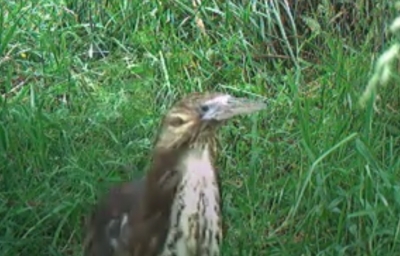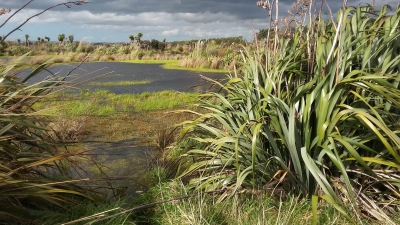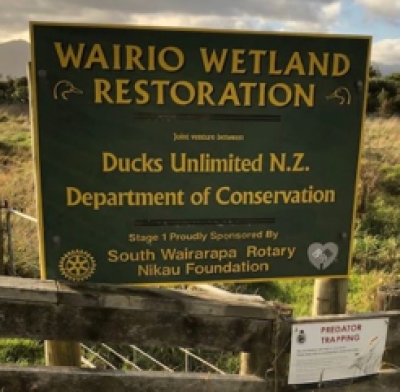Elusive Bittern caught on camera at Wairio Wetland
Jessica Wagner is a student at Victoria University of Wellington, researching rat response to scent and acoustic stimuli in the Wairio wetland. The intended outcome of Jessica's research is to determine what stimuli are most attractive to rats in order to improve trapping efforts, and ultimately, to protect rare birds such as the Bittern and wetlands in general.
Jessica was a recipient of one of the wetland care scholarships.
"I was recently going through my footage and noticed that one of my cameras has recorded a video of a Bittern on the 4th of December! I thought that you and others at Ducks Unlimited NZ may be interested in this so I have attached the video below. Feel free to share with anyone else who may be interested" (Jessica) .
Media
Research scholarships aid restoration of native wetlands
Thanks to Wetland Care Research Scholarships funded by Ducks Unlimited, our student researchers are finding the best ways to recreate a haven for waterfowl.
Wetlands in Aotearoa New Zealand are precious natural resources viewed as taonga by Māori, which provide a habitat for fish and birds.
Even in purely financial terms, wetlands are valuable for their role in filtering nutrients from water, absorbing carbon, and controlling erosion and flooding.
Sadly, they are now in crisis. With over 90% of our wetlands lost over the past 100 years, many plants and animals are struggling for survival, including the elusive matuku (Australasian bittern) and pūweto (spotless crake).
Help spot purple enemy at Lake Wairarapa
First recorded booming within the DU Wairio wetland
The spring 2022 survey report compiled by Shane Cotter, a contractor engaged by GWRC.
John Cheyne of Wetlands Works led annual spring surveys for Australasian bittern (matuku, Botaurus poiciloptilus) and spotless crake (pūweto, Zapornia tabuensis) at selected wetlands within Wairarapa Moana between 2012 and 2021. In 2022, John passed this responsibility to me. I conducted the annual spring (October-November) 2022 survey using the same methodology as in previous years so continued comparisons could be made of the annual results.
This year’s survey focused on the core wetlands (Boggy Pond, Matthew’s Lagoon and Wairio wetland) and the northern wetlands (Barton’s Lagoon, Tauherenikau delta, Simmond’s Lagoon, JK Donald Block). Only booming male matuku are surveyed because females are much less vocal and therefore very difficult to detect and monitor. This booming call is associated with males attempting to attract females for breeding. Pūweto were also surveyed at Boggy Pond and Matthew’s Lagoon.
In the 2022 survey, 11 booming male matuku were located at the core wetlands and 12 in the northern wetlands. This is an increase in previous years and a record number at both locations. At the core wetlands, numbers have remained relatively stable at 8-9 birds since 2014 while at the northern wetlands, annual numbers of male matuku has varied between 3-9 birds. Overall, the combined number of booming male matuku at the core and northern wetlands has steadily increased from 10 in 2016, to 16 in 2018, to 18 in 2020, and now 23 birds in 2022. In addition to the 23 male matuku heard booming during the 2022 survey, three other birds were seen, one in Matthew’s Lagoon near Boggy Pond and two in Wairio wetland.
At Boggy Pond, nine pūweto were located, the most in Boggy Pond since 2018 and significantly up on the single individual in 2021. At Matthew’s Lagoon, none were recorded during the kayak survey which has been a regular result there since 2014. While undertaking the matuku survey, four other pūweto were heard calling independently, not in response to playback calls. Two were calling in Matthew’s Lagoon close to each other while at two locations within Wairio wetland, one individual was heard calling. I believe there are more pūweto present than recorded during the pūweto surveys. They have just moved to different areas of the wetland complex outside the pūweto survey routes seeking more suitable habitat.
On-going predator trapping with the regular servicing of traps is essential as several predators were seen dead in traps within days of the traps being serviced and rebaited with fresh bait by the trapping contractor at the core wetlands. These included a weasel and several rats. All traps observed were well set up and maintained, and had good vegetation clearance.
Follow the 'read more' link to view the survey report.
Sunday 9 May 2021 at 12.30pm
Rural Women NZ Martinborough invite you to join them on a guided walk through
the Wairio Wetlands on the eastern shore of Lake Wairarapa.
4.2 km one-way, round trip 7 km. Return transport provided if required.
Witness the 15 year restoration programme led by Ducks Unlimited NZ.
Good walking track, sensible footwear required but unfortunately not suitable for wheelchairs.
No toilet facilities available. No dogs allowed. Will go ahead rain or shine.
Directions: From Kahutara Road turn on to Parera Road and continue for approximately 2.6 km.
The gathering point will be clearly indicated.
Cost is $5.00 per person, with all funds to support Associated Country Women of the World,
to assist with community projects in developing countries.
Contact: Marilyn Law 027 2239354 or Viv Malneek 027 5358805 if further information required.




